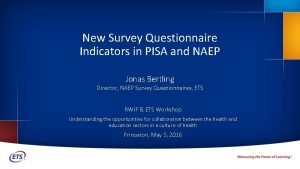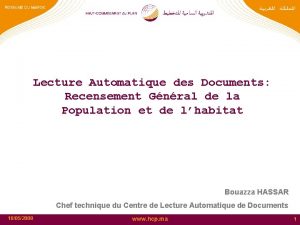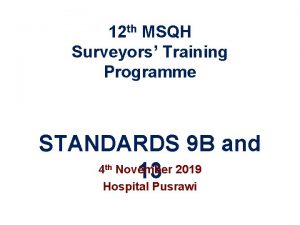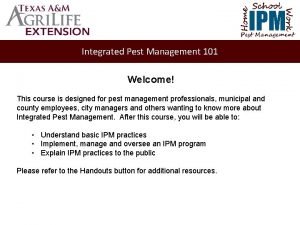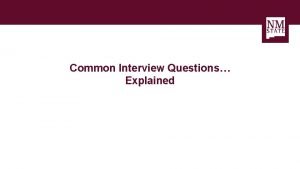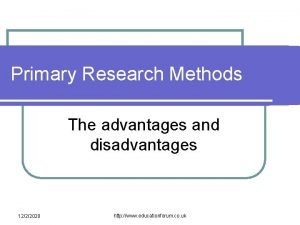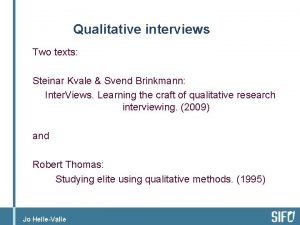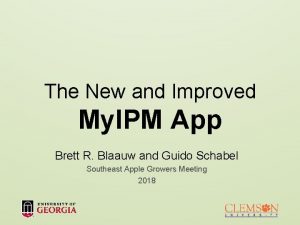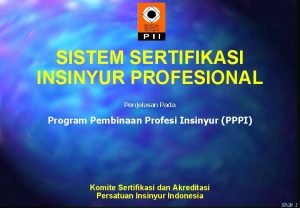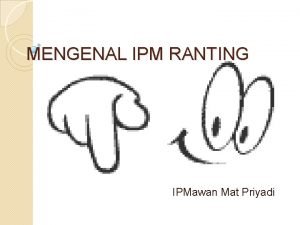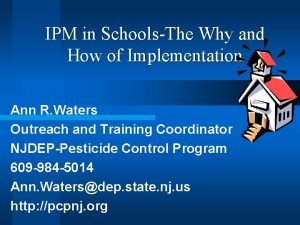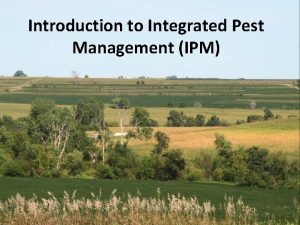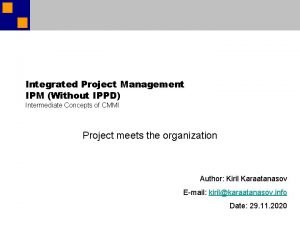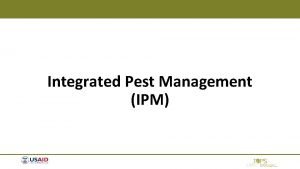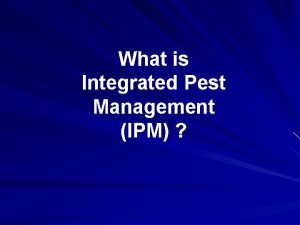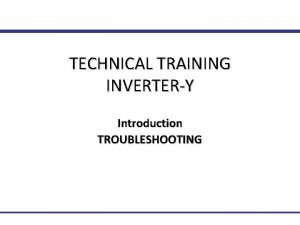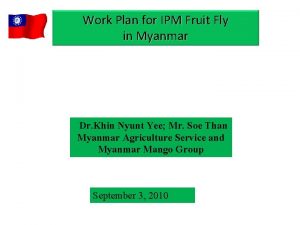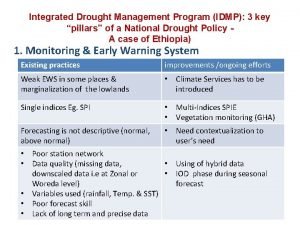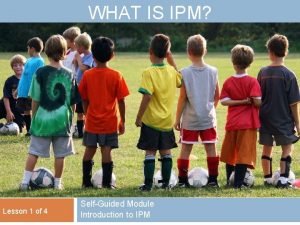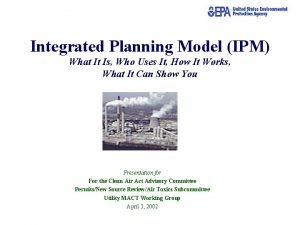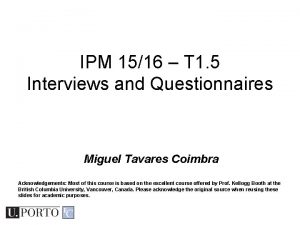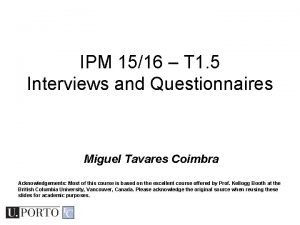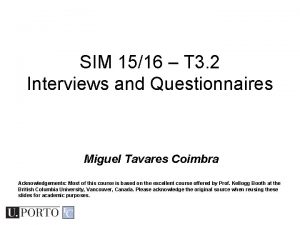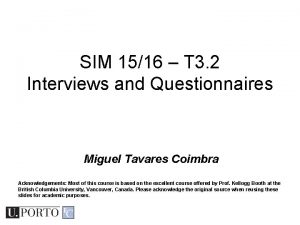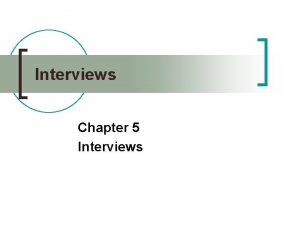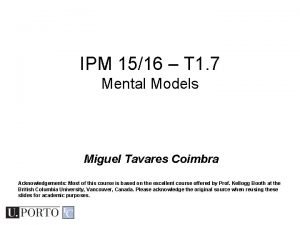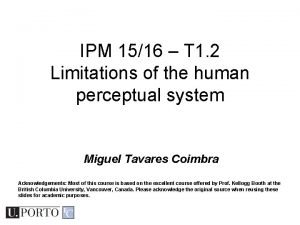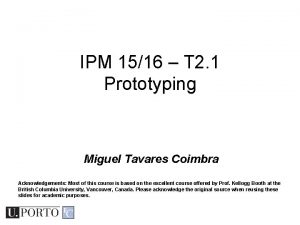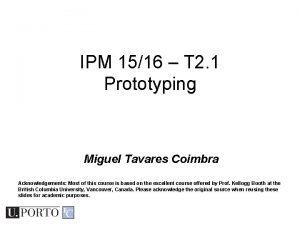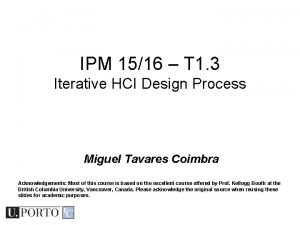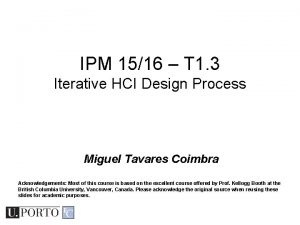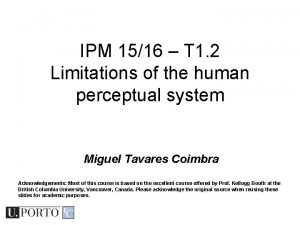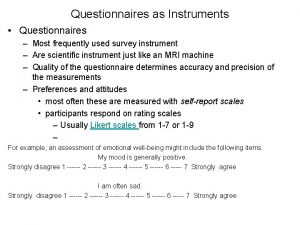IPM 1516 T 1 5 Interviews and Questionnaires




























- Slides: 28

IPM 15/16 – T 1. 5 Interviews and Questionnaires Miguel Tavares Coimbra Acknowledgements: Most of this course is based on the excellent course offered by Prof. Kellogg Booth at the British Columbia University, Vancouver, Canada. Please acknowledge the original source when reusing these slides for academic purposes.

Summary • Interviews • Questionnaires IPM 15/16 - T 1. 5 – Interviews and Questionnaires

Interviews and questionnaires • Two highly useful HCI evaluation techniques • Flexible: use anytime / anywhere – Adjust to suit design stage and circumstance • Obtain subjective responses from users – Self-reports – Manner of conducting evaluation can impact accuracy of the response IPM 15/16 - T 1. 5 – Interviews and Questionnaires

Querying users via interviews • “Conversations with a purpose” • Excellent for pursuing specific issues – More interaction than with observation: Address specific questions of interest – More flexible than questionnaires: Probe more deeply on interesting issues as they arise • Problems – – Accounts are subjective Time consuming (to conduct and to analyze) Evaluator can bias the interview Prone to rationalization of events/thoughts by user • User’s reconstruction may be wrong IPM 15/16 - T 1. 5 – Interviews and Questionnaires

Planning the interview • General – – – What is purpose of interview? List of interviewees (breadth vs. depth) Length of interview & number of sessions Scheduling interviews (location, times, people) Will the interview be recorded? (affects the outcome) Audio, video; transcription • Avoid: – – Asking long questions Using compound sentences Using jargon Asking leading questions … and generally be alert to unconscious biases. IPM 15/16 - T 1. 5 – Interviews and Questionnaires

Kinds of interviews • Three main types: 1. Open-ended / unstructured 2. Semi-structured 3. Structured • Other categories (can include types above): 4. Group 5. Retrospective IPM 15/16 - T 1. 5 – Interviews and Questionnaires

Unstructured interviews • Most like a conversation, often go into depth • Open questions • Exploratory Absolute key is to listen rather than talk: Practice silence! Pros/cons: • + rich data, things interviewer may not have considered • Easy to go off the rails • Time-consuming & difficult to analyze • Impossible to replicate IPM 15/16 - T 1. 5 – Interviews and Questionnaires

Structured interviews • Predetermined questions (like questionnaire, often with a flowchart) • Closed questions • Short, clearly worded questions • Confirmatory Pros/cons: • + replicable • - potentially important detail can be lost better (cheaper) with a questionnaire? IPM 15/16 - T 1. 5 – Interviews and Questionnaires

Semi-structured interviews In between structured & unstructured: • Seek a mix of constrained and unconstrained responses • Make sure to cover bases - e. g. list of items to definitely cover, responses to definitely get • Flexibility for open-ended follow-up as situation evolves In HCI, un- and semi-structured are the most common IPM 15/16 - T 1. 5 – Interviews and Questionnaires

Group interviews (focus group) • 3 – 10 people interviewed at one time • Usually has agenda, but may be either structured or unstructured • Skilled moderator critical! • Usually recorded Pros/cons: + can accommodate diverse and sensitive issues + opinions developed within a social context + good way to locate “proto-users”: most articulate, imaginative participants can help later w/participatory design - some interviewees may dominate - expensive: usually participants + professional moderator IPM 15/16 - T 1. 5 – Interviews and Questionnaires

Example of focus group: “soccer moms” (1997 -98) • Ethnographic research on an emerging market demographic – Women w/ kids + aging parents, primary role in family organization • Hypothesis: – Need better ways of keeping in touch with kids, parents, spouses & coordinating schedules • Study question: – What are their lives really like? what problems do they have? what do they want, & how much would they pay for it? – What do they think about some of our ideas? • Method: – Series of moderated focus groups: get discussion going on topics of interest through careful questions – Let group take some tangents; follow up on exceptions – Team observes unobtrusively; video record, extensive post-analysis IPM 15/16 - T 1. 5 – Interviews and Questionnaires

Retrospective interview • Post-test interview to clarify events that occurred during system use: – Record what happened, replay it, and ask about it Pros/cons: + excellent for following up and grounding an evaluation + avoids erroneous reconstruction + users often offer concrete suggestions - takes time; might require a second session IPM 15/16 - T 1. 5 – Interviews and Questionnaires

Overview of an exploratory (semi-structured) interview 1. Explain purpose of the interview – Allow time to get acquainted with the interviewee – Provide understanding and background 2. Enumerate activities – Find out what the user does 3. Explain work methods – Find out how the user does things (skills and knowledge) 4. Trace interconnections – Determine other people and activities that are related 5. Identify performance issues – Explore current problems and impediments to success IPM 15/16 - T 1. 5 – Interviews and Questionnaires

Things you uncover during interviews • Exceptions – – Lots of things people do are not “in the manual” Many jobs evolve to fit changing circumstances Much of this is not documented Many times “management” does not know about this • Domain knowledge – Most people know a lot about their jobs, and those they work with • Terminology, common phrases, specific details – Audio recording helps capture this – Video recording helps provide body language – Written notes can provide context, but not always details IPM 15/16 - T 1. 5 – Interviews and Questionnaires

Querying users via questionnaires (also called ‘surveys’) • Closed or open questions • Evidence of wide general opinion • Only as good as the questions asked Pros/cons: + preparation “expensive, ” but administration cheap • Can reach a wide subject group (e. g. mail or email) + does not require presence of evaluator + results can be quantified - can have low response rate and/or low quality response IPM 15/16 - T 1. 5 – Interviews and Questionnaires

Questionnaires: designing questions • Establish the purpose of the questionnaire: – What information is sought? – How would you analyze the results? – What would you do with your analysis? • Determine the audience you want to reach – Typical: random sample of between 50 and 1000 users of the product -- why a random sample? • Test everything before sending it out: – – Test the wording Test the timing Test the validity Test the analysis IPM 15/16 - T 1. 5 – Interviews and Questionnaires

Administering questionnaires in-person administration • requires time to administer, but highest completion rate “take home” (conventional) • often subjects don’t complete / return the questionnaire email • permits subjects to answer on their own time • responses may tend to be more free-form • attachments may be a problem • response rates depend on trust in source web-based forms • standardize formats and responses • Java/Javascript to ensure correct / complete general issues • payment or incentives • anonymity • self-selection IPM 15/16 - T 1. 5 – Interviews and Questionnaires

Styles of questions: open-ended • Asks for opinions • Good for general subjective information – But difficult to analyze rigorously For example, “Can you suggest any improvements to the interface? ” IPM 15/16 - T 1. 5 – Interviews and Questionnaires

Styles of questions: closed • Restricts responses by supplying the choices for answers • Can be easily analyzed … • But can still be hard to interpret, if questions / responses not well designed! – Alternative answers should be very specific IPM 15/16 - T 1. 5 – Interviews and Questionnaires

Styles of questions (closed): scalar --- Likert scale • Measure opinions, attitudes, and beliefs • Ask user to judge a specific statement on a numeric scale • Scale usually corresponds to agreement or disagreement with a statement IPM 15/16 - T 1. 5 – Interviews and Questionnaires

Styles of questions (closed): scalar --- semantic differential scale • Explore a range of bipolar attitudes about a particular item • Each pair of attitudes is represented as a pair of adjectives IPM 15/16 - T 1. 5 – Interviews and Questionnaires

Styles of questions (closed): multi-choice • Respondent offered a choice of explicit responses IPM 15/16 - T 1. 5 – Interviews and Questionnaires

Styles of questions (closed): ranked • Respondent places an ordering on items in a list • Useful to indicate a user’s preferences • Forced choice IPM 15/16 - T 1. 5 – Interviews and Questionnaires

Combining open-ended & closed questions • Gets specific response, but allows room for user’s opinion IPM 15/16 - T 1. 5 – Interviews and Questionnaires

Be considerate of your respondents • Not just because it’s nice, but it works better. • Questionnaire length (short is good): – Think in terms of reasonable completion times – Do not ask questions whose answers you will not use! • Privacy invasions: be careful how / what you ask • Motivation – Why should the respondent bother? – Usually need to offer something in return … but be careful about introducing bias. IPM 15/16 - T 1. 5 – Interviews and Questionnaires

Summary: questionnaires 1. Establish purpose 2. Determine audience 3. Variety of administration methods (for different audiences) 4. Design questions: – – Many kinds, depend on what you want to learn Most important distinction: open/closed (like structured/unstructured interview questions) 5. Be considerate of your respondents 6. Motivate your respondents (without biasing them) IPM 15/16 - T 1. 5 – Interviews and Questionnaires

Interviews and questionnaires: summary • Two highly useful HCI evaluation techniques • Flexible: use anytime / anywhere – Adjust to suit design stage and circumstance • Obtain subjective responses from users – Self-reports – Manner of conducting evaluation can impact accuracy of the response IPM 15/16 - T 1. 5 – Interviews and Questionnaires

Resources 1. Kellogg S. Booth, Introduction to HCI Methods, University of British Columbia, Canada http: //www. ugrad. cs. ubc. ca/~cs 344/curre nt-term/ IPM 15/16 - T 1. 5 – Interviews and Questionnaires
 Interviews and questionnaires
Interviews and questionnaires Phonepass test
Phonepass test Contoh angket terbuka
Contoh angket terbuka Naep survey questionnaires
Naep survey questionnaires Lecture automatique de questionnaires
Lecture automatique de questionnaires Msqh survey questionnaires
Msqh survey questionnaires Questionnaires about vaal river
Questionnaires about vaal river Cultural ipm
Cultural ipm Face to face interview pros and cons
Face to face interview pros and cons Greatest strengths and weaknesses
Greatest strengths and weaknesses Primary research advantages
Primary research advantages Kvale brinkmann
Kvale brinkmann My ipm
My ipm Program profesi insinyur
Program profesi insinyur Ipm adalah
Ipm adalah What is an ipm plan
What is an ipm plan Ipm meaning
Ipm meaning Cmmi ipm
Cmmi ipm Ipm meaning
Ipm meaning Objectives of integrated pest management
Objectives of integrated pest management Sejarah ipm
Sejarah ipm Invertery
Invertery Ipm myanmar
Ipm myanmar Pillars of ipm
Pillars of ipm Ipm grade 1
Ipm grade 1 Ipm indeks pembangunan manusia
Ipm indeks pembangunan manusia Ipm 410-3 (shikha) price
Ipm 410-3 (shikha) price Integrated planning model
Integrated planning model Ipm
Ipm



